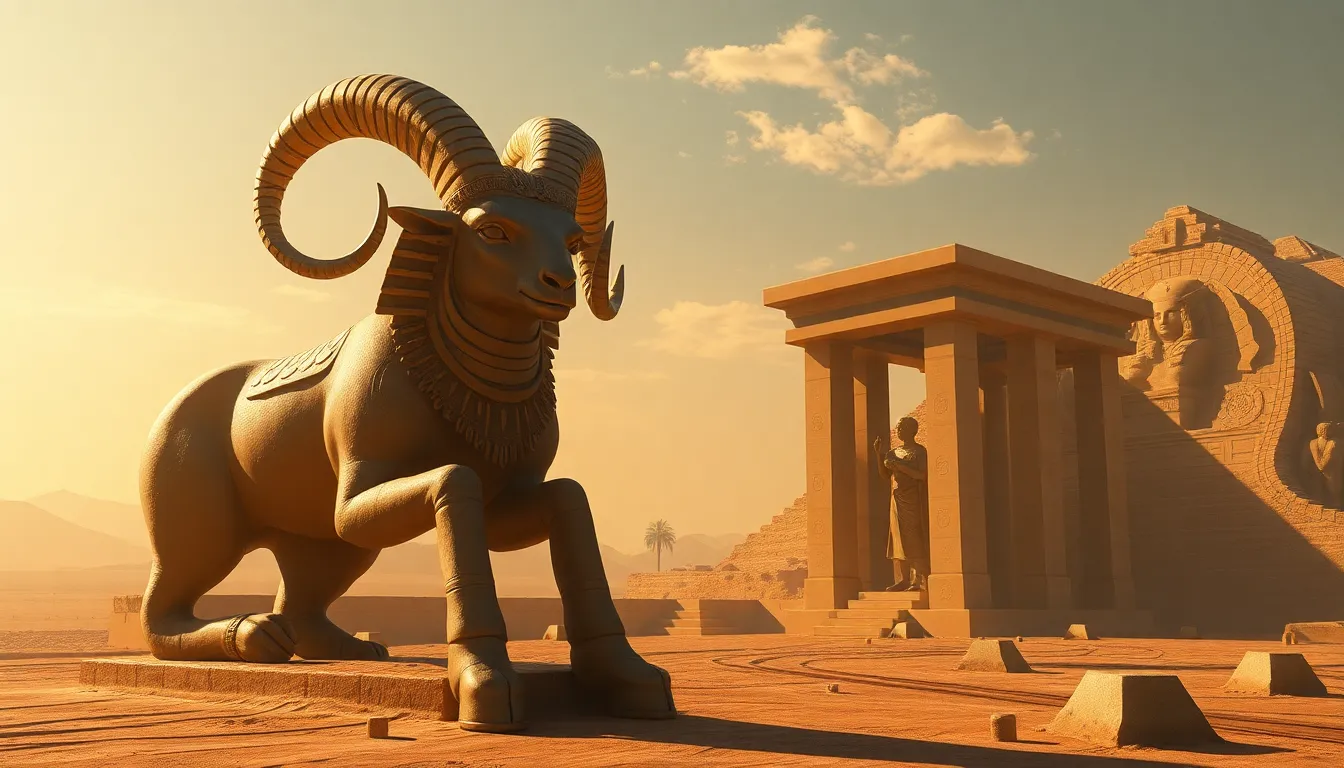The Geography of the Sacred Ram: Myths of Khepri
I. Introduction
In the rich tapestry of Ancient Egyptian mythology, Khepri stands out as a deity of immense significance, embodying creation, renewal, and the cyclical nature of life. Often depicted as a scarab beetle, Khepri is not merely a representation of physical strength but also a symbol of rebirth and transformation. The sacred ram, a creature deeply embedded in Egyptian culture, further enhances Khepri’s mythological narrative.
This article aims to explore the geographical and mythological aspects of Khepri, shedding light on how the sacred ram plays a pivotal role in these ancient beliefs. By examining the intertwining of geography and mythology, we can better understand the cultural narratives that shaped Ancient Egypt.
II. Khepri: The God of Creation and Renewal
Khepri, whose name translates to “he who is coming into being,” is primarily associated with the scarab beetle, a creature that symbolizes the sun’s journey across the sky. The scarab’s behavior of rolling dung into balls, which was likened to the sun’s movement, led to Khepri’s association with creation and rebirth.
In the Egyptian creation myth, Khepri played a crucial role in the emergence of the world from chaos. He was believed to have created himself from the primordial waters of Nun, bringing forth the sun and life. This act of creation resonates with the broader concept of rebirth, as Khepri was also seen as a harbinger of the new day, rolling the sun across the sky each morning.
III. The Sacred Ram in Egyptian Mythology
The ram holds a prominent place in Ancient Egyptian symbolism, often representing strength, fertility, and renewal. Rams were associated with several gods, most notably Amun, who was depicted as a ram-headed figure. This strong connection highlights the ram’s significance in religious practices and beliefs.
In the context of Khepri, the sacred ram serves as a powerful symbol of renewal and fertility. Khepri’s connection with the ram illustrates how different animal symbols can overlap in mythological narratives, creating a rich and complex understanding of divinity in ancient cultures.
IV. Geographical Significance of Khepri’s Worship
The worship of Khepri was deeply rooted in the geography of ancient Egypt. Key locations, such as Heliopolis, were central to Khepri’s veneration. This city, known as the “City of the Sun,” was a focal point for solar worship, where Khepri was celebrated as a major deity.
- Heliopolis: The primary center of worship for Khepri.
- The Temple of Amun: Located in Karnak, where Khepri was honored alongside other deities.
- Other significant sites: Memphis and Thebes also played roles in Khepri’s worship.
The temples and monuments dedicated to Khepri were designed to reflect his solar aspects, often aligned with celestial phenomena. The geographical positioning of these sites facilitated the spread of Khepri’s myths, intertwining them with the rhythms of the Nile and the solar cycle.
V. Myths and Legends Surrounding Khepri
Numerous myths surround Khepri, particularly those that connect him to the sacred ram. One popular legend depicts Khepri rolling the sun across the sky each day, symbolizing the rebirth of Ra, the sun god. This daily renewal echoes the regenerative qualities attributed to the sacred ram.
As these myths evolved over time, they incorporated various geographical elements that influenced their interpretations. For instance, the annual flooding of the Nile represented a cycle of death and rebirth, mirroring Khepri’s role in the cosmos.
VI. The Intersection of Geography and Mythology
The interplay between geography and mythology was crucial in shaping Khepri’s narrative. Geographic features like the Nile River, desert landscapes, and the surrounding mountains directly influenced religious beliefs and practices.
Natural landscapes often served as backdrops for mythological events, reinforcing the connection between the physical world and divine actions. For example:
- The Nile’s flooding represented the cyclical nature of life and death, akin to Khepri’s rebirth themes.
- Mountains were viewed as sacred spaces, often associated with the gods and their stories.
Specific myths, such as the daily journey of the sun, were intrinsically linked to the land, showcasing how geography shaped the mythology of Khepri and the sacred ram.
VII. Legacy of Khepri and the Sacred Ram in Modern Culture
Today, Khepri’s influence can be seen in various contemporary interpretations of Egyptian mythology. Artists, writers, and filmmakers draw inspiration from Khepri’s symbolism of renewal and transformation, reflecting a continued fascination with this ancient figure.
The legacy of the sacred ram also persists in modern culture, appearing in:
- Art: Depictions of Khepri and the ram can be found in various artistic works.
- Literature: References to Khepri and the ram appear in both historical texts and modern storytelling.
- Popular Culture: Movies and video games often incorporate these mythological elements, keeping the stories alive.
Recent archaeological findings further enrich our understanding of Khepri and ram worship, revealing new insights into the practices and beliefs of ancient Egyptians.
VIII. Conclusion
In summary, the exploration of Khepri and the sacred ram reveals the profound connections between geography and mythology in Ancient Egypt. Khepri’s role as a god of creation and renewal is intricately linked to the sacred ram, symbolizing the cyclical nature of life. The geographical significance of Khepri’s worship highlights how the environment shaped religious beliefs and practices.
As we continue to study these ancient narratives, we uncover the lasting relevance of Khepri and the sacred ram in understanding the complexities of Egyptian mythology. The interplay between geography and mythology not only enriches our knowledge of ancient cultures but also invites us to reflect on the timeless nature of these stories in shaping cultural identities.




